My Mentors, Colleagues, and Friends in Separation Science and Technology, Part II
LCGC North America
This final installment of Klaus Unger's personal reflections and scientific activities covers from 1990 until his retirement in 2010.
In the second phase of my career, international collaborations continued to play a central role.
This installment is a continuation of the personal reflections documented in Part I (1) of this two-part article. Here, I discuss the second phase of my scientific activities, from 1990 until my retirement in 2010. Topics will include the impact of liquid chromatography (LC) in life sciences starting with multidimensional LC–mass spectrometry (MS), proteomics, and related approaches. After the response on the publication of part I, I decided to continue with part II to complete my personal reflections.
The Successful Route to Biopolymer Separation (The ISPPP Symposia)
The International Symposium on the Separation of Proteins, Peptides, and Polynucleotides (ISPPP) was established in 1981 in Washington, D.C. (see Part I). The aim was to achieve superior resolution and speed in the analysis of biopolymers as compared to the classical methods using soft gels. Last year marked the 30th anniversary of the ISPPP conference, held in Bologna, Italy. The 31st conference will take place October 23–26, 2011, in Alexandria, Virginia. It is worthwhile to examine why and how this symposium series has maintained such longstanding importance.
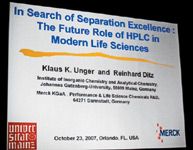
Figure 1: Title of the last oral presentation of Klaus K. Unger at the 27th ISPPP meeting in Orlando, Florida, in October 2007.
Shortly after its successful start in November 1981, the scientific committee was expanded by two European scientists: Jan Christer Janson of Pharmacia AB (Uppsala, Sweden) and Klaus K. Unger of the University of Mainz, Germany. The conference was held biannually alternating between the United States and Europe.
In contrast to more recent editions of the conference, the ISPPP conferences from the 2nd to the 16th, with the exception of the 12th and the 15th, were prepared entirely by a team of five members of the scientific committee. In other words, no single chairman was elected, rather the whole committee took responsibility. The scientific program was always established in a two-to-three day planning meeting somewhere in the world. I have rarely experienced such an effective and thorough preparation of a scientific meeting.
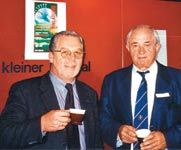
Figure 2: Karl-Siegfried Boos (left) of the Laboratory of Bioseparation, Institute of Clinical Analysis, Medical Center of the University of Munich, Germany with Klaus K. Unger at a workshop in Munich in 1997.
Furthermore, it should be emphasized that the scientific committee was never bound to any society or instrument company and we were able to focus on the most relevant and hot topics in this field. The conference was sponsored by various firms throughout the years, including Varian Inc., Tosoh Inc,. Pharmacia AB, Merck KGaA, and others.
In these early years, the primary focus was elucidating the fundamentals of biopolymer separation and the kinetic and thermodynamic phenomena involved rather than practical applications. The major scientific achievements were published in Journal of Chromatography under the supervision of Eric Heftmann at Elsevier Science Publishers, Amsterdam, Netherlands (17 volumes in total). One can easily conclude that many major achievements in this field originated from these meetings and were disseminated to the international scientific community.
Sample Cleanup — The Forgotten Field in LC
Today, high performance liquid chromatography (HPLC) is primarily performed with mass-sensitive detectors such as mass spectrometers in an on-line or off-line mode. In contrast to this high-tech technique, sample cleanup of complex samples is frequently still carried out with archaic methods, for example by extraction methods that are not automated and exhibit bad reproducibility. To increase reproducibility, sample cleanup procedures should be automated and — if possible — be integrated into the LC separation process. The fact that biological and environmental samples are highly complex and the target analytes are present in minute amounts means the tasks are twofold: first, to remove or deplete the highly abundant species in the sample and second, to enrich and selectively capture the target analytes.
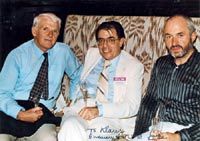
Figure 3: Meeting of three chairmen of the PREP symposium at the International HPLC symposium held in 1988 in Washington, D.C. From left to right: the late Maurice Verzele (Ghent, Belgium), George Guiochon (Knoxville, Tennessee), and Klaus K. Unger (Mainz, Germany).
One effective means to accomplish these tasks is to use specially designed adsorbents that possess a high capacity and selectivity for nondesired species, but also a high selectivity for the desired analytes. The latter can be small organic molecules, but might also involve peptides or proteins.
One important development in sample cleanup was the concept of restricted access materials (RAM), which was developed and continuously improved over a period of 20 years. I.J. Hagestam and T.C. Pinkerton (2) were the first who made pioneering studies in this field in the mid 1980s. The major characteristic of RAM particles is their dual surface functionality: a hydrophilic outer surface and a pore surface with bonded hydrophobic or ion-exchange groups. Thus, they are working as size-exclusion adsorbents either through the size of the pores, a polymer network, or a layer covering the external surface. There were numerous attempts to synthesize these RAM adsorbents reproducibly, selectively, and in a sufficiently stable way for multiple use in automated sample cleanup systems.
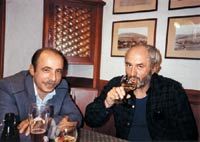
Figure 4: Alexander (Sascha) Kurganov (left) and Klaus K. Unger (right), enjoying a glass of wine at the restaurant "Hoher Knuck" in the forest area east of Frankfurt in 1990.
In the 1990s, the most significant contributions in the field of RAM were made by Karl Siegfried Boos and colleagues at the Laboratory of Bioseparation at the Institute of Clinical Analysis in the Medical Center of the University of Munich, Germany (3). I collaborated with Boos and his team on the synthesis of RAM for the sample cleanup of low-molecular-weight compounds out of biofluids; those materials have a hydrophilic outer surface and a hydrophobic inner surface, an average pore diameter of 6 nm, and an average particle diameter of 25 µm. The RAM columns were part of an automated HPLC system in which the RAM columns were automatically loaded with an aliquot of the sample and washed, the analytes were eluted, and columns were regenerated. The column stability was outstanding, and the column could be used for several thousand injections. Later, we were able to develop RAM columns for the sample cleanup of peptides and proteins being incorporated into a multidimensional LC system for peptide and protein analysis (4). These RAM columns exhibited a hydrophilic outer surface and ion-exchange groups, such as sulfonic acid groups at the inner surface. The RAM columns were commercialized by Merck KGaA, Darmstadt, Germany.
Based on the RAM concept, Karl-Siegfried Boos and his colleague Rosa Morello recently developed a unique, automated platform for blood analysis in which they combined sampling and in-line processing of whole blood with on-line solid-phase extraction (SPE)–LC–MS-MS.
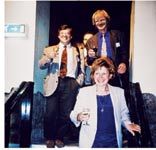
Figure 5: Alexander Neimark (top left ), Ferdi Schueth (top right), and Olja Neimark (bottom) at a reception at COPS IV in Bath, UK, in 1996.
My Steps into Proteomics and Peptidomics — A Decade of Missed Opportunities
With 20 years of experience dealing with the separation of proteins and peptides and good knowledge of multidimensional LC, our group stepped enthusiastically into proteomics at the beginning of the millennium. We hoped to implement multidimensional LC, including sample cleanup, as an effective analytical tool to generate quantitative results as opposed to the established 2D gel electrophoresis–based methods.
The first hurdle to overcome was the fact that any successful technique should be hyphenated to mass spectrometry as a mass separator and mass-sensitive detector. To acquire the required MS instrument from the university was a hopeless undertaking. Instead, I turned to my Swedish friends in the pharmaceutical industry and contacted György Marko-Varga and Lars-Erik Edholm from AstraZeneca R&D in Lund, Sweden. We started an intensive collaboration and were able to construct, build, and operate a fully automated 3D LC–MS platform for biomarker research in Lund (5). In the following years we were able to reduce the complexity of the platform and enhance its robustness by developing a 2D system that included sample cleanup that was based on RAM technology. We were able to analyze up to several thousand peptides and proteins with a molecular weight of <20 kDa, most of which had a molecular weight between 500 and 4000 kDa.

Figure 6: Heavy discussion on the pros and cons of fractal analysis at COPS I, in Bad Soden, in 1987, between Klaus K. Unger (left) and David Avnir of Hebrew University, Jerusalem, Israel (right).
Our success was mainly due to the outstanding skills and experience of Knut Wagner who was a Ph.D. student and Egidijus Machtjevas who was a postdoctoral researcher.Several outstanding features characterized our collaboration, including that we had access to well-defined and selected samples; we were able to test the performance of our system with real samples; and we had access to various types of mass spectrometers. The downside was that AstraZeneca ran the systems with proprietary samples and we were not allowed to publish the resulting data. We were fortunate to continue our research in this field to demonstrate the potential of multidimensional LC in proteomics through a project with Merck KGaA and the Charite hospital at the University of Berlin (Berlin, Germany) to investigate marker peptides that are decisive in the transplantation of human kidneys. The starting point was the technology transfer of our analytical platform to the Charite, using selected samples. During this transfer operation, we encountered the typical problems of proper collection, handling, processing, and reporting of complex information and analytical protocols between laboratories operating with different levels of experience. One of the lessons learned was that exploiting the potentials of multidimensional LC requires either significant experience and skill with the technology or a fully automated system to permit data acquisition by less experienced individuals.
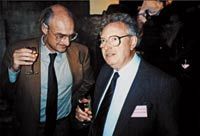
Figure 7: John D. Ramsay of CRNS, Montpellier, France (left) and Ken S.W. Sing of the University of Exeter, UK (right), at a reception at COPS IV held in Bath, UK, in 1996.
In spite of our effots, today LC is reduced to a front-end technique in proteomics: The sample cleanup is performed on selective affinity- or immuno-adsorbent columns and the proteins, after a digest, are analyzed by reversed-phase silica capillary LC coupled to MS. Multidimensional LC has not found its place as a workhorse in this field, but to extract sufficient information from proteomic systems will require functional information on the protein level, not just on the peptide fragment level, as is the case today.
The Road to Preparative and Process LC (1986–2006)
In a review article published in 2010 (6), we wrote, "Liquid chromatographic methods cover the broadest range of applications imaginable today. Nowhere is this more evident and relevant than in life sciences, where identification of target substances relevant in disease mechanisms is performed down to the femtomole level. On the other hand, purification of therapeutic drugs on a multiton scale is performed by process LC. The complexity and abundance range of biological systems in combination with the extreme purity requirements for drug manufacturing are the challenges that can be mastered today by liquid chromatography, after more than a century of research and development."
For many years, although analytical HPLC was discussed worldwide in conferences and forums, information on preparative and process separations by LC was rather limited. This was mainly due to two factors: First, prep and particulary process LC require special equipment and engineering skills to design, perform, and optimize the procedures to ensure high purity, high yield, and adequate cost; second, such large-scale purification processes are developed as part of the production process of value-added chemicals or biotherapeutics and therefore often represent proprietary know-how.
George Guiochon from the department of chemistry at University of Tennessee (Knoxville, Tennessee) was the first to start an international conference on preparative and process LC called PREP. The first PREP conference was held in 1985 in Washington, D.C., and has been held annually since. The first European conference on preparative and scale-up LC took place in January 1986 in Paris and was organized by Lucien Charles of Amicon Inc. (now part of Millipore, Billerica, Massachusetts). The meeting in Paris became an enormous success, with about 600 participants. It was decided to continue this conference series, also called PREP, in Europe every second year. The following European PREP meetings were held in Baden-Baden, Germany (1988); Ghent, Belgium (1990); Nancy, France (1992); Baden-Baden, Germany (1994); and Basel, Switzerland (1996). From 1998 on PREP was renamed the Symposium on Preparative and Industrial Chromatography and Allied Techniques (SPICA) and organized biannually in Switzerland, Austria, and Germany.
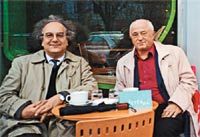
Figure 8: Enjoying the city of Lubljana, Slovenia, during the 20th ISPPP in November 2000. Left: Athanasios I. Liapis of Missouri University of Science and Technology, Missouri; right: Klaus K. Unger.
The PREP and SPICA meetings have been remarkably successful for two reasons. First, the conferences were accompanied by an instrument exhibition where one could get in-depth information about the growing market. For example, at the 1988 conference in Baden-Baden, Germany, 45 companies in total took part at the exhibition. One company (Prochrome, Nancy, France) could not even bring its large preparative column into the exhibition, because the prep system could not fit through the entrance door of the conference center. It remained outside over the full length of the symposium as an attractive symbol. Second, the PREP and SPICA symposia served as a forum to propagate novel methodologies and technologies such as the periodic countercurrent operation of beds. This technique was first applied industrially as simulated moving bed (SMB) technology by UOP LLC (De Plaines, Illinois) for the separation of isomers. The fundamental theory of the mass transfer and fluid mechanics for continuous beds as well as for periodically moving beds was treated in depth by A.I Liapis and D.W.T. Rippin (7). During the 1990s, this technique was down-scaled and quickly became the number one purification technique for the production of enantiomerically pure drugs in the pharmaceutical industry.
My Russian Liaison: An Unforgettable Experience
I must smile when scientists and in particular politicians emphasize the term globalization. Back in the 1970s we built a global network of scientists in the United States, Western Europe, Japan, and even the Soviet Union. The Cold War still separated the West and the East, but we tried our best to expand our contacts and enhance our links to Russia and its excellent scientists. It became extremely difficult for Russian scientists who were not members of the Communist party to leave the country to attend international conferences in the West. The famous A.V. Kiselev of Lomonossow University (Moscow, Russia) was a good example.
In 1982, I had the pleasure to meet Vadim Davankov of the Nesmejanow Institute of Organo Element Compounds at the Academy of Sciences (Moscow, Soviet Union) at a Gordon conference on ion exchange in Wolfboro, Massachusetts. Vadim's specialization was the separation of enantiomers by ligand-exchange chromatography (LEC), using amino acid complexes with copper as the metal atom.
Vadim spent nearly a year with me as a visiting professor at the Technical University of Darmstadt working on the resolution of enantiomers by LEC. Later, Vadim became one of the most renowned scientists in the field of enantioseparation. He also successfully worked in the area of hyper cross-linked polymers and edited a book on this subject last year. He is still active at his institute in Moscow and we are still good friends.
Vadim had a very talented colleague, Alexander (Sascha) Kurganov, who joined my group for nearly a decade, from 1984 to 1994, at the Johannes Gutenberg University in Mainz, Germany. He ran his own laboratory, as an off-site branch of our laboratory at the university clinics, with his wife Tatjana. Their laboratory was nicknamed the "Moscow lab" because the official language was Russian. Sascha returned to Moscow in 1995 and became the head of the laboratory on gas chromatography that was previously led by Victor Berezkin.
After the collapse of the Soviet Union, a number of scientists left Russia. Among them was Alexander Neimark and his family. Alex was a surface scientist and worked at the famous Dubinin Institute of Physical Chemistry of the Academy of Sciences in Moscow. He applied for a Humboldt fellowship with my group, received it, and stayed one year. During that period surface science fractals were being applied to all surface phenomena of porous solids, and Alex became very active in that. We were able to receive an additional visiting professorship for Alex for another year before he moved to the Centre National de la Recherche Scientifique (CNRS) in Poitiers, France. Our collaboration with Alex and Peter Ravikovic, his research associate, developed into one of the most productive periods in the field of characterization of porous solids. We published nearly 20 scientific papers on numerous subjects. I share a very warm friendship with Alex and his wife Olja.
Alex went on to Yale University (New Haven, Connecticut) and then to TRI Princeton (Princeton, New Jersey) where he built up a famous group of surface scientists. Peter Ravikovich was one of his most talented students. Alex went on to become a full professor at Rutgers University (New Brunswick, New Jersey).
I would like to add that Alex established a workshop on the characterization of porous solids entitled "From Angstroms to Millimeters," which became the U.S. counterpart of our successful conference on the characterization of porous solids (COPS).
Toward the Understanding of Surfaces and Pores: Characterization of Porous Solids (COPS) — A European Exercise
When I began dealing with the synthesis and manufacture of silicas for separation, I had to develop an understanding of the world of surfaces and pores. Characterization of porous materials and finely divided materials was commonly performed by gas sorption methods and was, at that time, the playground of famous British researchers such as Douglas Everett, Ken Sing, and others. I came to know these tycoons personally during meetings held in Western Europe, such as at the workshop on porous solids held in July, 1978 in Neuchatel, Switzerland, and at the Reunion Internationale de Laboratoires d'Essays et de Recherche sur les Materiaux et le Constructions (RILEM) RILEM/Conriglio Nationale delle Richerche (CNR) international symposium held in April, 1983, in Milan, Italy. At these occasions, I also had the unique opportunity to get to know two of the most famous Russian scientists in this field: A.V. Kiselev and M.M. Dubinin from Moscow, Soviet Union.
The focus of discussion at these meetings was the interpretation of sorption data and the various ways to assess the parameters of the pore structure of materials. With the continuous assistance of my colleague Erich Robens, who is an expert in sorption balances, we built up one of the largest laboratories on adsorption at a university in West Germany.
In 1987, three of us (Ken S.W. Sing, Jean Rouquerol, and I) started the COPS series of international conferences. The first meeting was held in Bad Soden, Germany, in 1987. We decided to hold COPS every third year in Western Europe and it became the leading scientific forum for the characterization of porous solids. At these meetings, the most relevant methods for the characterization of porous solids were discussed and later published. Those activities led to the International Union of Pure and Applied Chemistry (IUPAC) recommendation of porous solids as guidelines for scientists and engineers.
The European Research, Training, and Mobility Program: What Politicians Can Never Achieve!
Based on the contacts among the four chairmen of COPS (K.S.W. Sing, J. Rouquerol, P. Rodriguez-Reinoso, and I), we started the first collaboration program in the European Union to exchange Ph.D. students. In the following years, I had three Ph.D. students from the UK performing the experimental part of their Ph.D. thesis mainly in the field of synthetic zeolites: Michael Keung, Dipika Kumar (both from the Brunel University, Uxbridge, UK) and Simon Reitmaier (from the University of Manchester, UK).
Later, we established several EU programs under the framework of the Research, Training and Mobility (TRM) program, in which we exchanged not only Ph.D.s but also post docs from several European countries over a period of more than 10 years.
Needless to say, this collective exercise formed the basis for an intensive scientific exchange, dissemination, and collaboration within the EU member states without any political involvement.
Material Design by Delving into Modeling and Simulation
The third important step in this field was undertaken in the 1990s when we dealt with a promising separation method called capillary electrochromatography (CEC). In CEC, mobile phase movement is generated by the electroendosmotic flow applied by an electrical field and not by applying pneumatic pressure as in liquid chromatography. The equipment we used was modified capillary electrophoresis equipment provided by Agilent Technologies (Waldbronn, Germany).
Thousands of scientific papers were published on CEC during this period because it had a couple of advantages over HPLC. First, we were able to apply micrometer-size and submicrometer-size particles with surface charges packed in fused-silica capillaries. Second, CEC enabled us to separate polar, cationic, and also anionic analytes. After we solved some hardware problems to run packed fused-silica capillaries our focus was the resolution of mixtures of hormonal peptides in collaboration with Milton T.W. Hearn of the department of biochemistry at Monash University (Melbourne, Australia) and Ferring AB (Malmö, Sweden). We achieved fascinating selectivities, but we were unable to understand the retention mechanism.
In 2002, at the 20th ISPPP conference held in Lubljana, Slovenia, I met Athanasios (Tom) Liapis of the department of chemical engineering at Missouri University of Science and Technology (Rolla, Missouri). Tom is a chemical engineer who is doing theoretical work on the modeling of the constitutive equations of the fundamental mechanisms of momentum (fluid mechanics and dynamics), heat, and mass transfer, including electrophoretic migration, in systems involving species separations and chemical and biochemical reaction engineering.
After our meeting in Lubljana, Tom and his colleagues dealt with the fundamentals of CEC in packed columns. From their simulations using the mathematical model they constructed and developed, they were able to accurately predict the behavior of our experimental results on the performance of fused-silica capillary CEC columns packed with reversed-phase silica particles with average diameters of 0.5–3 µm.
Long before our meeting at Lubljana, Liapis and my laboratory were already collaborating on the characterization (for example, of pore size distribution and pore connectivity)
of porous particles and monolithic materials by using pore network models constructed and developed by Liapis's group. We also used these models to determine intraparticle pore diffusion coefficients for the diffusing species, as well as to quantify the mass transfer kinetics in such porous materials.
Lessons That Life Taught Me
The interested reader might ask what factors contributed the most to my professional accomplishment. They were
- The chance to meet highly knowledgeable older colleagues with rich experience who became my mentors and gave me valuable and personal advice to follow.
- I was able to develop a network of specialists in science and industry from around the world. I got to know many of these scientists personally and developed close friendships with them over the years.
- Over nearly four decades I was able to assemble a highly motivated group of young students and researchers to whom I gave responsibility and free space to pursue and reach their own research and development goals.
- I had the unique opportunity to perform research and development during a period of peace and economic growth.
- I received strong support from the beginning and continuously throughout many decades from the chemical industry, instrument manufacturers, and a large number of funding organizations in Germany and Europe.
- I always learned from my students and was open to what happened in both industry and academia. I taught numerous courses around the world for students and participants from industry for more than 30 years, which gave me a lot of satisfaction and enjoyment.
When I turned 65 in 2001, I had to retire from the University of Mainz. At that time, I still had a group of twelve Ph.D. students left who needed my support and help. Because of my long cooperation with Merck KGaA of Darmstadt, the division of performance and life science chemicals headed by Karl Heinz Derwenskus gave us a home at the company and substantial support to continue our research in the field of proteomics and design of materials for LC for another nine years. In 2009, my last Ph.D. student, Romas Skudas, finished and I terminated my first retirement period.
I am now in my second retirement period enjoying writing, reading, hiking, meeting friends, and watching the flight of the geese flying North at my cottage in South Sweden.
Acknowledgment
I would like to thank Reinhard Ditz, innovation technologies, Merck KGaA, Darmstadt, Germany for his advice and corrections.
Klaus K. Unger is a professor at the Institute of Inorganic Chemistry and Analytical Chemistry of Johannes Gutenberg-University, Mainz, Germany, +49 6151 152630, k.k.unger@web.de
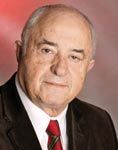
Klaus K. Unger
Reference
(1) K.K. Unger, LCGC N. Amer. 29(4), 326–336 (2011).
(2) I.J. Hagestam and T.C. Pinkerton Anal. Chem. 57, 1757–1763 (1985).
(3) K.S. Boos and C-H. Grimm, TrAC 18, 175–180 (1999).
(4) E. Machtejevas and K.K.Unger, Sample Preparation of HPLC-based Proteome Analysis in Proteomics Sample Preparation, J.von Hagen, Ed., (Wiley-VCH , Weinheim, pp 245–271, 2008).
(5) K. Wagner et al. Anal.Chem. 74, 809–820, (2002).
(6) K.K. Unger, R. Ditz, E. Machtejevas, and R. Skudas, Angew.Chem. Int. Ed. 49, 2300–2312 (2010).
(7) A.I Liapis and D.W.T. Rippin, AIChE 25, 455–466 (1979).
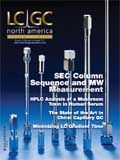
New Method Explored for the Detection of CECs in Crops Irrigated with Contaminated Water
April 30th 2025This new study presents a validated QuEChERS–LC-MS/MS method for detecting eight persistent, mobile, and toxic substances in escarole, tomatoes, and tomato leaves irrigated with contaminated water.

.png&w=3840&q=75)

.png&w=3840&q=75)



.png&w=3840&q=75)



.png&w=3840&q=75)









